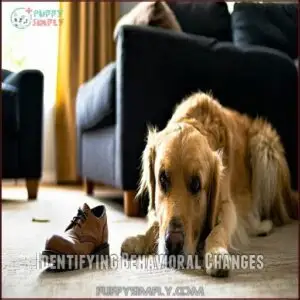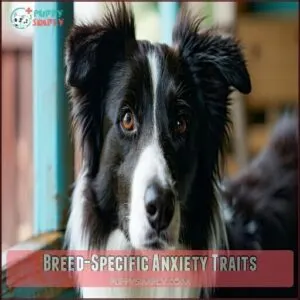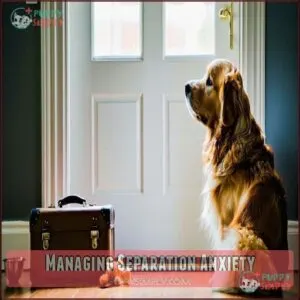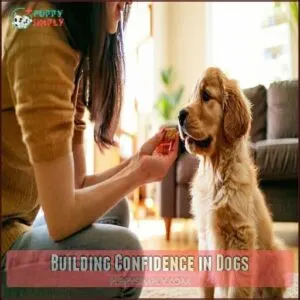This site is supported by our readers. We may earn a commission, at no cost to you, if you purchase through links.
 To calm down a dog, start by creating a peaceful environment—lower the noise, dim the lights, and give them space if needed.
To calm down a dog, start by creating a peaceful environment—lower the noise, dim the lights, and give them space if needed.
Gentle touch works wonders; try slow strokes along their back or chest. Soft classical music or calming scents like lavender can also help.
If they’re anxious, a consistent routine and exercise can reduce their stress. For high-energy dogs, a quick walk or play session might do the trick.
Pay attention to their body language—ears back or pacing might mean they’re overwhelmed. Every dog’s different, so it’s about finding what soothes yours best. Curious about advanced calming techniques? Keep reading!
Table Of Contents
- Key Takeaways
- Calming Dog Anxiety Signs
- How to Calm Down Dogs
- Calming Methods and Strategies
- Advanced Calming Techniques
- Frequently Asked Questions (FAQs)
- How can I help my dog calm down?
- How to stay calm to help your dog stay calm?
- How do you calm a dog if he is anxious?
- How can I help my dog calm down during a thunderstorm?
- How do I calm my dog down asap?
- How do you calm a hyper dog?
- What is the 3 3 3 rule for dogs with anxiety?
- Where do you touch a dog to calm down?
- What is the 3-3-3 rule for dog anxiety?
- What helps my dog calm down?
- Conclusion
Key Takeaways
- Create a calm environment by lowering noise, dimming lights, and providing a safe space with familiar items.
- Use calming techniques like gentle petting, classical music, or lavender aromatherapy to ease your dog’s stress.
- Stick to a consistent routine and include regular exercise to help prevent anxiety and hyperactivity.
- Recognize early signs of anxiety, such as shaking or pacing, and address triggers with desensitization or calming aids.
Calming Dog Anxiety Signs
You’ll spot dog anxiety through telling signs like shaking, cowering, heavy panting, yawning, and lip-licking before it escalates into destructive behavior.
Recognizing these signals early gives you a vital head start in calming your furry friend quickly, much like catching a pot before it boils over, which is a vital step in preventing further issues.
Recognizing Body Language
I’ll help you create concise content about recognizing dog body language that shows anxiety.
In the face of anxiety, your dog’s body language speaks volumes. Recognizing these stress signals early helps you intervene before anxiety escalates.
Watch for these key anxiety indicators:
- Tucked tail, flattened ears, and whale eye (showing whites)
- Excessive panting, drooling, or yawning when not tired
- Stiff posture, raised hackles, or lowered body stance
This knowledge is crucial for early intervention.
Identifying Behavioral Changes
While body language offers immediate clues, your dog’s behavioral changes often signal deeper anxiety issues.
Watch for sudden aggression, appetite changes, sleep disturbances, excessive vocalization, or destructive tendencies that weren’t there before.
These fear-based behaviors don’t appear overnight—they’re like warning bells ringing louder over time.
Your once-playful pup destroying furniture or a normally sociable dog hiding away suggests something’s triggering their anxiety that requires your attention, indicating a need to address the underlying cause of these behavioral changes.
Understanding Environmental Factors
Your dog’s surroundings can trigger anxiety you mightn’t notice.
Loud noises like fireworks or construction often cause noise sensitivity, while unfamiliar visual stimuli can startle them.
Temperature control matters too—dogs get stressed when too hot or cold.
Pay attention to scent influences in your home that might upset territory security.
Understanding these environmental factors is essential for addressing anxious dog behavior effectively.
Breed-Specific Anxiety Traits
Did you know that your dog’s breed substantially influences their anxiety patterns?
Lagotto Romagnolos and mixed breeds often show noise sensitivity, while Shetland Sheepdogs typically fear strangers.
Border Collies exhibit compulsive staring behaviors, but rarely display social fear.
Miniature Schnauzers tend toward aggression with stranger anxiety, unlike Labrador Retrievers.
Understanding these breed-specific anxiety traits helps you anticipate and address your dog’s unique stress responses effectively, which is crucial for their well-being and can help you provide the best possible care, considering their anxiety patterns.
Past Trauma and Stressors
Shadows from the past often haunt your dog’s present behavior. Past trauma and early experiences can create lasting fear imprints that trigger anxiety years later.
Past experiences leave deep imprints, shaping your dog’s fears and anxieties long after the events have passed.
You’ll notice PTSD signs when specific situations resemble previous abuse history. Understanding these trauma triggers helps explain seemingly random reactions.
Dogs don’t "just get over it" – their psychology creates deep connections between experiences and responses, requiring patient, consistent stress reduction techniques during training.
Addressing these issues often requires behavioral modification strategies to help with stress reduction and behavioral modification.
How to Calm Down Dogs
Calming down a dog can feel tricky, but it’s all about understanding their needs and environment.
With the right techniques, you’ll help your furry friend relax and feel secure in no time.
Effective Calming Techniques
Understanding your dog’s anxiety signs is step one, but calming them takes action.
Try these dog calming techniques:
- Use pheromone therapy or herbal remedies like chamomile for relaxation.
- Play dog calming music to ease tension.
- Practice touch techniques, like gentle stroking, for comfort.
- Explore exercise benefits to burn off nervous energy.
These simple dog relaxation methods work wonders! They can help with calming your dog.
Reducing Stress and Anxiety
Stress can sneak up on your pup, but you’ve got tools to help.
From calming products to anxiety relief techniques, a few adjustments can work wonders.
Here’s a quick guide:
| Technique | Benefit | Example | Ease of Use | Cost |
|---|---|---|---|---|
| Classical Music Therapy | Soothe dog anxiety | Play soft classical tunes | Easy | Low |
| Aromatherapy | Reduce dog stress | Lavender diffuser | Moderate | Medium |
| Physical Contact | Promotes relaxation | Gentle petting | Easy | Free |
| Exercise | Anxiety prevention | Walks or fetch | Easy | Free |
| Diet Adjustments | Enhances mood stability | Balanced meals | Moderate | Medium |
Tackle stress with these dog calming techniques!
Creating a Calm Environment
To create a calm environment, set up a safe space with comfort items like a favorite blanket or toy.
Use sound masking, such as white noise or calming music, to reduce stimulation.
Stick to routine consistency to soothe dog anxiety and reduce dog stress.
Calming products for dogs, like pheromone diffusers, can also help calm an anxious dog effectively, and following these steps can lead to a more calm environment.
Managing Separation Anxiety
When leaving, avoid obvious departure cues like jingling keys.
Gradual desensitization helps—start with short absences and increase time slowly. Interactive toys or puzzle feeders keep your dog’s mind busy, offering anxiety relief.
Use dog calming products like pheromone diffusers for added comfort. Always make certain of a safe return, reinforcing trust.
For severe dog separation anxiety, seek professional help for effective dog anxiety management.
Building Confidence in Dogs
Boost your dog’s confidence with positive reinforcement and training games.
Socialization skills help them navigate the world, while overcoming fears builds trust.
Use dog psychology to understand their behavior, and dog communication to reassure them.
Gradually expose them to new experiences, rewarding calmness.
Confidence grows when they feel safe, so focus on consistent dog training and patience.
Rottweilers may experience anxiety from confusing commands, so make sure cues are clear.
Calming Methods and Strategies
When your dog’s anxiety takes over, knowing the right calming methods can make all the difference.
From soothing music to gentle touch, these strategies help create a sense of security and ease for your furry friend.
Classical Music Therapy
Music therapy is a soothing way to ease dog anxiety.
Classical music works wonders for calming dogs, lowering heart rates, and encouraging relaxation.
Try creating a playlist suited to your pup’s preferences.
- Opt for slower tempos (50-60 beats per minute).
- Keep the volume level comfortable, not overwhelming.
- Explore albums like Through a Dog’s Ear for long-term benefits.
Aromatherapy for Dogs
Classical music soothes dogs, but aromatherapy adds another layer of calm.
Lavender and chamomile are top dog-calming scents, reducing anxiety through diffuser usage or topical applications. Always prioritize essential oil safety—dilute properly and avoid harmful oils like citrus.
Many owners find a calming diffuser effective for anxious dogs.
Pheromone therapy or pre-mixed sprays offer convenience, while herbal remedies like chamomile tea provide natural relaxation. Dogs deserve spa days too!
| Method | Benefit | Application | Safety Tip |
|---|---|---|---|
| Lavender Oil | Reduces anxiety | Diffuser or bedding | Dilute to avoid irritation |
| Chamomile | Promotes relaxation | Mist or tea | Vet consultation recommended |
| Pheromone Therapy | Mimics maternal signals | Diffuser or spray | Use vet-approved products |
| Pre-Mixed Sprays | Convenient calming solution | Spray on fur | Avoid eyes and nose |
Physical Contact and Touch
Physical contact can work wonders for calming your dog.
Use gentle petting techniques to lower their heart rate, but avoid excessive hugging—it can feel restrictive.
Massage benefits include easing tension and promoting relaxation.
Try touch therapy with calming vests for added security.
Encourage sniffing during petting sessions to slow their breathing and help them unwind naturally.
- Practice soothing petting techniques.
- Avoid hugging dangers; keep it light.
- Use calming vests for touch therapy.
- Try dog massage techniques for relaxation.
- Encourage sniffing to promote calmness.
Exercise Routines for Stress Relief
After soothing your dog with touch, channel their energy into exercise.
Walking benefits both of you, offering mental stimulation and endorphin release that eases stress.
Playtime activities like fetch or tug-of-war burn off extra dog energy while reinforcing routine consistency.
Breeds like pointers benefit from consistent daily exercise to reduce hyperactivity.
Regular dog routines create calming habits, making exercise one of the simplest, most effective dog calming exercises to reduce anxiety.
Desensitization and Counterconditioning
How do you help a dog overcome anxiety triggers without overwhelming them?
Start with desensitization—gradually expose your dog to triggers in small, controlled doses.
Pair this with positive association, using treats or praise to build comfort.
Stick to reward systems and avoid flooding, which can escalate stress.
These dog training techniques guarantee effective dog behavior modification while reducing dog anxiety.
Consistent Routines and Schedules
Dogs thrive on predictability.
A consistent dog routine, like regular feeding times, consistent walks, and bedtime rituals, keeps them calm and secure.
Establishing a dog habit or pattern helps reduce anxiety, as they know what to expect, and training consistency also reinforces good behavior.
Think of it as their version of a daily planner—minus the coffee breaks!
Teaching Dogs to Settle and Relax
After establishing routines, teaching your dog to settle enhances their impulse control.
Use a settle cue during relaxation protocols, pairing it with positive reinforcement like treats or praise.
Mat training works wonders—encourage your dog to associate the mat with calmness.
These dog calming techniques help anxious dogs unwind, making dog relaxation techniques a reliable tool for stress relief.
Calm Spaces With Sensory Stimulation
After teaching your dog to settle, enhance their relaxation with a sensory-enriched safe zone.
Use calming textures like soft blankets, paired with visual stimulation from dim lighting.
Add olfactory comfort with lavender-scented calming products for dogs or dog calming pheromones.
These safe spaces provide anxiety relief for dogs, promoting dog relaxation while giving them a cozy retreat from stress.
Consider purchasing a dog calming blanket for added comfort.
Managing Noise and Stressors
Loud noises like thunderstorms or fireworks can rattle even the calmest dogs.
For stress reduction, try these:
- Use calming aids like white noise machines or fans to mask unsettling sounds.
- Play classical music to ease dog thunderstorm anxiety and create a serene vibe.
- Stick to routine consistency during noisy events for anxiety relief in dogs.
These tricks work wonders!
Building a Safe Space
A quiet, cozy spot works wonders for calming dogs.
It is their personal den—a safe crate or corner with comfort items like blankets and toys.
Add sound dampening (a fan or white noise) to ease dog anxiety.
Gradual introduction is key; let them explore without pressure.
A well-prepared safe space can transform dog stress relief into a breeze.
| Safe Space Tip | Why It Works | How to Implement | Bonus Benefit |
|---|---|---|---|
| Den Location | Instinctual comfort | Choose a quiet, low-traffic area | Reduces overstimulation |
| Comfort Items | Familiar scents relax | Add blankets and favorite toys | Boosts security |
| Sound Dampening | Blocks scary noises | Use fans, sound machines, or music | Lowers anxiety levels |
| Gradual Introduction | Builds trust | Let them explore freely | Encourages positive behavior |
Advanced Calming Techniques
When basic methods don’t quite cut it, advanced calming techniques can help you address deeper anxiety in your dog.
From massage to specialized supplements, these strategies offer targeted ways to bring your pup some peace.
Deep Breathing Exercises and Massage
For a calm anxious dog, try diaphragmatic breathing exercises by modeling slow, deep breaths to help them relax.
Pair this with gentle massage techniques, focusing on their shoulders and chest.
Use positive reinforcement, like treats or praise, to associate these relaxation techniques with comfort.
Mental stimulation is also key for relaxation.
These methods promote anxiety relief in dogs, reducing tension while strengthening your bond.
Lick Mats and Scent Work for Calming
Lick mats are a lifesaver for anxious pups, offering both enrichment and calmness.
Spread peanut butter or yogurt on them to create a soothing distraction—perfect for anxiety relief in dogs.
Many owners find these calming mats beneficial.
Pair this with scent training games, like hiding treats, to engage their nose and mind.
These canine enrichment ideas double as calming products for dogs needing stress relief.
Physiotherapy and Chiropractic Care
If your dog’s stress feels like a knot you can’t untangle, physiotherapy and chiropractic care might be the answer.
Techniques like joint mobilization and muscle relaxation improve posture, aid pain management, and prevent injuries.
Chiropractic care can help alleviate anxiety by addressing vertebral subluxations.
These methods also support dog anxiety relief and enhance overall dog health. A relaxed body often leads to a calmer mind.
Consulting a Veterinary Behaviorist
Sometimes, dog anxiety needs expert help. A veterinary behaviorist can tackle complex cases with specialized training in dog behavior.
They’ll assess your pup, explore medication options if needed, and craft a customized plan.
- Get peace of mind from behavior experts.
- Address severe issues with professional veterinary advice.
- Navigate treatment costs and find qualified specialists near you.
Using Calming Aids and Supplements
Herbal remedies, calming treats, and dog pheromones can work wonders for anxious pups.
Pairing a dog calming vest with essential oils like lavender enhances relaxation.
Here’s a quick guide:
| Aid Type | Key Ingredient | Duration (hrs) |
|---|---|---|
| Calming Treats | Chamomile, Melatonin | 3-5 |
| Hemp Oil | CBD | 6-8 |
| Pheromone Therapy | Synthetic pheromones | 8-12 |
| Essential Oils | Lavender, Chamomile | 2-4 |
Always consult your vet before trying new dog medication to ensure the best approach for your anxious pup.
Frequently Asked Questions (FAQs)
How can I help my dog calm down?
Imagine your dog pacing during a storm—play soft classical music or use a lavender diffuser to create calm vibes.
Pair that with gentle petting or a massage, and you’ll see stress melt away.
How to stay calm to help your dog stay calm?
Stay calm by taking deep breaths and maintaining a steady tone.
Dogs mirror your emotions, so staying relaxed helps them feel secure.
Think of yourself as their anchor in a storm—grounded, steady, and reassuring.
How do you calm a dog if he is anxious?
Play calming classical music or use a white noise machine to mask triggers.
Offer gentle petting or massage, and try lavender aromatherapy.
Physical exercise, a calming vest, or a safe space also helps.
How can I help my dog calm down during a thunderstorm?
Thunderstorms can feel like a drum solo in your dog’s head.
Use calming music, like classical, to mask the noise, try a Thundershirt for comfort.
Diffuse lavender oil to create a soothing atmosphere.
How do I calm my dog down asap?
Try stroking your dog gently for a few minutes, focusing on their chest or behind the ears.
Play calming classical music or use lavender aromatherapy.
A quick walk or engaging sniffing game can also help.
How do you calm a hyper dog?
Did you know 25 minutes of exercise can substantially reduce a dog’s stress?
Take your hyper pup for a brisk walk, then follow up with a calming massage or soothing classical music to settle them down.
What is the 3 3 3 rule for dogs with anxiety?
The 3-3-3 rule helps anxious dogs adjust: three days to decompress, three weeks to settle into routines, and three months to build trust and feel at home.
Patience and consistency make all the difference!
Where do you touch a dog to calm down?
A gentle touch works wonders—focus on stroking your dog’s chest, behind their ears, or along their back.
These areas are like their “calm buttons,” helping to lower stress and build trust with soothing contact.
What is the 3-3-3 rule for dog anxiety?
The 3-3-3 rule helps dogs adjust after adoption: three days to decompress, three weeks to settle into routines, and three months to feel truly at home.
Patience and consistency make all the difference!
What helps my dog calm down?
Picture your dog as a stressed-out roommate—soothing classical music, lavender scents, or a calming vest works wonders.
Add exercise, gentle petting, or a safe space, and you’ll have a much calmer companion.
Conclusion
Sometimes, it’s like your dog knows you’re stressed too—calming them can feel like teamwork.
By understanding their body language, creating a peaceful environment, and trying techniques like gentle touch or aromatherapy, you’ll see what works best for your furry friend.
Don’t forget, a consistent routine and exercise can work wonders for their anxiety.
Every dog is unique, so be patient and observant.
With these tips, you’ll know exactly how to calm down a dog quickly and effectively.


















